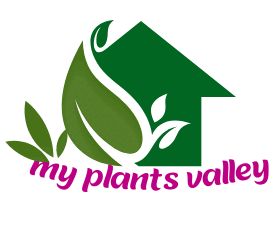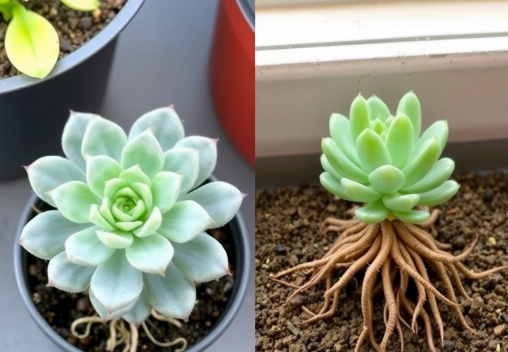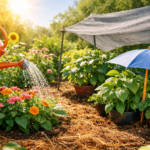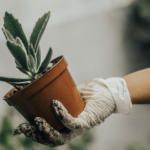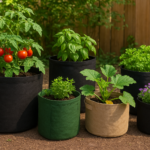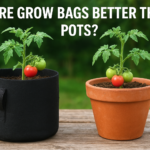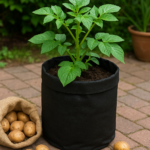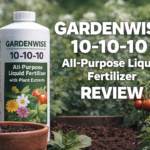Regarding succulents, Echeveria plants are among the most adored by gardeners and plant enthusiasts. If you’re wondering, “How large do potted echeveria grow?” you’ve come to the right place. Whether you’re a seasoned succulent keeper or a beginner looking to nurture your first plant, understanding the growth potential of your potted Echeveria is crucial for creating a thriving indoor garden.
What is Echeveria?
Echeveria, a genus of succulent plants native to semi-desert areas of Central America, has captivated plant lovers with its rosette-shaped leaves and striking colors. These plants are renowned for their resilience and minimal care requirements, making them perfect for both indoor and outdoor cultivation. Yet, even though they’re low-maintenance, the size of a potted Echeveria is influenced by several factors, ranging from pot size to environmental conditions.
The Origin and History
Echeveria plants are named after Atanasio Echeverría y Godoy, a botanical illustrator who contributed to the study of Mexican flora in the 18th and 19th centuries. Over the years, these succulents have evolved to adapt to arid conditions, developing water-storing leaves that make them ideal for dry, sunny environments. Their storied past contributes to their popularity in modern horticulture, where they continue to inspire both collectors and casual gardeners alike.
Key Characteristics of Echeveria
Echeverias are easily recognized by their symmetrical rosettes and fleshy leaves. These succulents come in a variety of colors, from soft greens to deep blues and even pinkish hues. Each species varies slightly in growth habits, leaf shape, and size, yet all share a common resilience and capacity to thrive in minimal water conditions. This adaptability is one of the reasons they have become a staple in succulent collections around the world.
Why Size Matters in Potted Plants

The size of your potted Echeveria isn’t just about aesthetics. A plant that grows too large for its container may become root-bound, affecting its overall health and appearance. Understanding the growth parameters helps you create a balanced environment where your plant can reach its full potential without compromising its health.
Ideal Growing Conditions for Echeveria
Temperature Requirements
Echeverias prefer warm conditions, ideally thriving in temperatures ranging from 65°F to 80°F (18°C to 27°C). They are not frost-tolerant, so if you’re growing them indoors or in climates with cold winters, it’s essential to provide a stable, warm environment. When the temperature is just right, these succulents can maximize their growth potential.
Sunlight and Light Exposure
Sunlight is a key factor in the development of Echeveria. These plants flourish with plenty of bright, indirect sunlight. Direct, harsh sunlight can scorch their leaves, while too little light might result in a leggy, weak plant. Striking the right balance is essential to ensure healthy growth and vibrant coloration in your Echeveria.
Soil and Drainage Needs
The foundation of any thriving succulent is well-draining soil. Echeverias require a soil mix that mimics their natural habitat—a gritty, sandy mix that prevents water from pooling around the roots. Good drainage is crucial because excess moisture can lead to root rot, stunting the plant’s growth and potentially causing severe damage.
How Pot Size Influences Echeveria Growth

Choosing the Right Pot
A well-chosen pot is essential to support the growth and overall health of your Echeveria. First, consider the size of the pot. It should be large enough to allow the roots to spread and grow, but not so big that it holds excess moisture which could lead to root rot. Ideally, opt for a pot that is only slightly larger than the current root system, ensuring that the plant’s growth is not stunted by a cramped environment.
Key points to consider when choosing a pot include:
- Drainage: Ensure your pot has several drainage holes to prevent water from accumulating at the bottom.
- Material: Terracotta or unglazed ceramic pots are excellent choices because they allow for natural evaporation, reducing the risk of overwatering.
- Stability: A pot with a wide base provides stability, especially as your Echeveria grows taller.
- Aesthetic: Choose a pot that complements your décor and the natural beauty of your succulent collection.
Material and Design Considerations
Not all pots are created equal. For optimal growth, choose a container with ample drainage holes and a design that promotes air circulation around the roots. Materials like terracotta are popular because they are porous, which helps evaporate excess moisture, ensuring that your Echeveria’s roots remain healthy and oxygenated.
Effects of Pot Size on Root Development
The size of the pot directly affects root development. In a confined space, roots have limited room to spread out, which can slow overall plant growth. Conversely, a larger pot provides the opportunity for the roots to expand, supporting a bigger, healthier plant. However, it’s important to strike a balance, as too much space without proper drainage can lead to overwatering issues.
Watering, Fertilization, and Maintenance
Watering Techniques
Watering is an art when it comes to succulents. Echeverias are drought-tolerant and store water in their leaves, so overwatering is a common mistake. The ideal practice is to water thoroughly, allowing the soil to dry out completely between watering sessions. In potted environments, always check the moisture level of the soil before adding more water.
Nutrient Requirements
Echeverias are low-maintenance succulents that require minimal nutrients to thrive. During the growing season, typically spring and summer, apply a diluted, balanced fertilizer once every four to six weeks to support steady growth. Over-fertilization may result in rapid yet weak development, so use fertilizer sparingly. In winter, when these plants enter dormancy, nutrient requirements diminish, making fertilization unnecessary. Using a well-draining, nutrient-rich soil mix during repotting also provides a consistent supply of essential minerals. By following this balanced approach, you ensure your Echeveria remains healthy, vibrant, and robust throughout its growth cycle. Proper care fosters long-term thriving of beautiful succulents..
Seasonal Care Tips
During the warmer months, Echeverias grow more actively and may require more frequent watering and feeding. In contrast, the winter season is a period of dormancy. Adjust your care routine accordingly—reduce watering and avoid fertilization during the colder months to prevent stress on the plant.
- Spring: As temperatures rise, begin repotting and refresh the soil. Increase watering gradually and start light fertilization to encourage new growth.
- Summer: Provide ample, bright light while watering deeply but infrequently, ensuring the soil dries between sessions to prevent root rot. Monitor for heat stress and adjust care as needed.
- Autumn: Gradually reduce both watering and fertilizing. Remove any dead or damaged leaves to prepare the plant for a slower growth period.
- Winter: Echeverias enter dormancy. Water sparingly, avoid fertilization, and keep the plant in a bright, sheltered spot to protect against cold drafts.
Maximum Growth Potential of Potted Echeveria

Typical Size Range
Under optimal conditions, most potted Echeverias will reach a mature rosette diameter of around 4 to 6 inches. However, size can vary widely depending on the specific species, environmental factors, and the care provided. Some varieties might remain compact, while others can spread out a bit more.
Variations Among Species and Cultivars
Different species of Echeveria have distinct growth patterns. For instance, Echeveria elegans often forms tight, small rosettes, whereas Echeveria ‘Lola’ may expand to a larger size under the right conditions. When selecting an Echeveria for your collection, consider the natural size and growth habit of the species to ensure it fits well in your chosen pot.
Common Myths and Facts About Echeveria Size
Debunking Misconceptions
There are many myths surrounding the growth of potted Echeveria. One common misconception is that these plants will eventually outgrow any container if given enough time. In reality, while Echeverias can grow steadily, their size in a pot is typically limited by the container itself, along with environmental factors and care routines.
The Truth About Overcrowding
Another myth is that overcrowding in a pot will lead to larger growth. Overcrowded conditions can actually stunt the plant’s development and lead to issues such as fungal infections or root rot. It’s best to ensure that each plant has enough space to breathe and grow without competition for nutrients.
Tips for Maximizing Growth in Potted Echeveria
Best Practices for Potting and Repotting
For optimal growth, choose a pot that complements the size of your Echeveria and provides sufficient drainage. Repotting should be done carefully—typically every couple of years—to refresh the soil and allow for root expansion. When repotting, gently tease out the roots and remove any that have become damaged or overly congested.
Strategic Pruning and Propagation
Pruning is not only about maintaining an attractive shape; it can also promote healthier growth. Removing dead or damaged leaves allows the plant to focus its energy on new, vibrant growth. Additionally, Echeverias can be propagated from leaf or stem cuttings, giving you the chance to create more plants without overcrowding your existing container.
Troubleshooting Common Growth Issues
Identifying Common Problems
Even with the best care, your Echeveria might face challenges. Common issues include overwatering, under-lighting, or poor soil drainage. Signs such as mushy leaves, discoloration, or stunted growth can indicate that something isn’t quite right with the plant’s environment.
Effective Solutions
Addressing these issues starts with a careful diagnosis. For instance, if your plant shows signs of overwatering, reduce the frequency of watering and ensure that the pot has proper drainage. In cases of under-lighting, consider relocating your Echeveria to a brighter spot. Often, simple adjustments can make a significant difference in the overall health and growth of your succulent.
Frequently Asked Questions (FAQs)
Q1: How big can a potted Echeveria get?
A1: Most potted Echeverias will reach a mature rosette diameter of 4 to 6 inches under optimal conditions, although this can vary by species and care practices.
Q2: Can I grow Echeveria outdoors in a pot?
A2: Yes, Echeverias thrive outdoors in warm climates with plenty of sunlight. Ensure the pot has good drainage and bring the plant indoors if temperatures drop below its tolerance level.
Q3: How often should I water my potted Echeveria?
A3: It’s best to water thoroughly and then allow the soil to dry out completely between watering sessions. Overwatering can lead to root rot, so adjust the schedule according to the plant’s needs and seasonal changes.
Q4: What type of soil is best for Echeveria?
A4: A well-draining, sandy or gritty soil mix is ideal. You can also use a cactus or succulent mix, which is specifically formulated to prevent excess moisture retention.
Q5: Can I increase the size of my Echeveria by repotting into a larger container?
A5: Yes, repotting into a slightly larger container can promote growth by allowing the roots to expand, but be cautious not to choose an overly large pot, which might lead to moisture retention issues.
Conclusion
Echeverias are truly captivating succulents that bring an exotic charm to any space. By understanding their unique needs and the factors that influence their growth, you can ensure your potted Echeveria reaches its full potential without outgrowing its container. From selecting the right pot and soil to mastering watering techniques and debunking common myths, every aspect of care plays a crucial role in the plant’s health and size. With these insights and practical tips, you are now equipped to nurture your Echeveria into a vibrant, flourishing centerpiece that not only looks stunning but also thrives in its environment.
Gardening, much like any art, requires observation, patience, and a bit of trial and error. So, whether you’re repotting an established plant or propagating new ones, keep experimenting and learning from each experience. Ultimately, your attention to detail and willingness to adapt will yield a healthy, well-sized Echeveria that brightens up your living space and stands as a testament to your green thumb.
